For over half a century the Chinese Nationalist Party’s (KMT) patronage faction system remained fairly stable, but then quickly evolved with democratization. To understand these fascinating developments, we have to first understand how the system evolved in the first place.
The KMT’s Republic of China (ROC) government faced several dilemmas after it fled to Taiwan.
One was maintaining the fiction that they represented “Free China” to the world and in the UN. Through masterful use of the “China lobby” in Washington DC, the US Congress was spending billions propping up Generalissimo Chiang Kai-shek’s (蔣介石) regime. Remarkably, it even still had some idealistic followers.
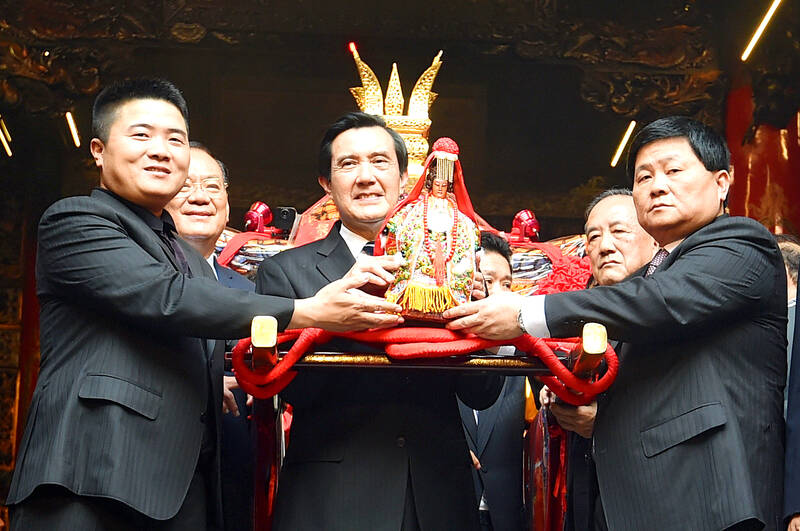
Photo: Liao Yao-tung, Taipei Times
Few in the KMT could speak the local languages, and few locals could speak Mandarin. They could — and did — shoot or jail anyone even remotely suspected of being against the regime or of being a Communist sympathizer, but they needed local supporters they could rely on.
At the national level, they justified imposing martial law, claiming a still ongoing Chinese Civil War, and to mobilize the nation against Communism and “retake the mainland.”
Seats in the Legislative Yuan covered the entirety of China, even though the KMT had no control over any of it. Those elected to the legislature in 1947 would permanently represent those seats — all the way up to the 1990s, by which point many of the legislators were in wheelchairs.
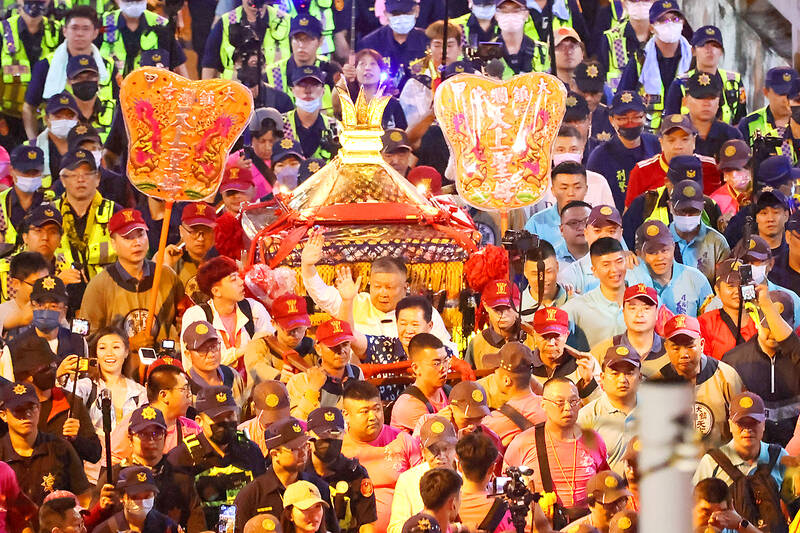
Photo: Chen Kuan-pei, Taipei Times
To keep control of political parties, they banned the formation of new ones, leaving only the KMT and a handful of smaller puppet parties founded in China.
AN EFFECTIVE METHOD OF CONTROL
With these factors in mind, they started holding local elections. They were legitimate enough that from time to time independent candidates would win.
To maintain control at local level, the KMT turned to Taiwanese elites.
These elites joined the KMT but split into factions, turning elections into battles between KMT candidates aligned with different factions made up of Taiwanese.
These factions — whom the KMT did not trust — were banned from spreading or making alliances outside of their local city or county.
To fund their campaigns, build client networks and line their own pockets, these factions took control of agricultural and irrigation associations, local credit cooperatives and similar local functions.
These elites took control of temples, which, to this day, are known for money laundering due to lax reporting requirements. This is still true, and the chairman of Jenn Lann Temple, which runs the world’s largest Matsu pilgrimage, is Yen Ching-piao (顏清標), the head of Taichung’s Black Faction.
Temples also had what I have dubbed “temple toughs,” young men trained to fight, some of whom trace their lineage to Qing Dynasty-era militias.
Having control of the levers of government and the police — which often had ties to organized crime — few could stand in their way.
They also lined their pockets with bribes and during government land auctions few would have the courage to bid against them, ensuring them cheap access to property.
All this made it very hard for independent candidates to break through.
The corruption inherent in the system put them at the mercy of the KMT.
The most common names for these factions were usually the surname of the founder (“Hsieh faction”) or the colors red, white and black. The three colors came from the color of the leaflets used in their very first election, and the names stuck.
By the 1980s and 1990s powerful factional politicians and their family clans had amassed considerable property and wealth.
WHAT I WITNESSED FIRST HAND
This was my introduction to Taiwan politics.
I taught at four cram schools across Changhua County and two were owned by powerful factional county councilors, including the one who owned the cram school in Hemei Township (和美), where I lived.
There is not much online about him, but my ex-girlfriend at the time remembers his full name as Chen Chung-tsai (陳忠財).
I called him “Mr. Chen” and he found it very amusing to take my 19 and 20-year-old self out drinking. I suspect he was showing me off at a time when Westerners were rare.
He drank all day and all night with everyone from constituents to local business owners to government officials, and there was much debauchery and womanizing.
As a good politician, Chen would match the drink of choice to the status of who was drinking with — illegal moonshine rice wine with farmers to expensive French cognac with factory owners and government officials.
I remember him pounding on my door at 10:30am — unnerving behavior from a boss — to get ready to go drink in downtown Changhua City at a KTV. I eventually convinced him I was not a daytime drinker, but I had not yet learned how to put my foot down with the boss.
The first time I encountered vote buying was at a cram school, where I saw a mountain of neatly stacked NT$500 banknotes. Curious about what the money was for, I joked: “is that for me?”
They said matter of factly that it was for buying votes. The money was on the counter of the cram school and anyone passing by could easily see it through the wall-sized window facing the street.
I was told later that Chen died in his late 40s from throat cancer, unsurprising considering all his smoking and betel nut chewing.
CHANGE ON THE HORIZON
This system thrived from the late 1940s well into the 1990s, but democracy inevitably brought change and hostility from some in the higher echelons of the KMT, dominated by those from families who had fled the Chinese Civil War. They viewed the brazen corruption of the factions a stain on the party’s image at a time when it was facing significant electoral competition.
Possibly their fiercest foe was then justice minister and future president Ma Ying-jeou (馬英九).
In an upcoming column we will examine that story and much more that changed the factions starting in the later 1990s onwards.
Donovan’s Deep Dives is a regular column by Courtney Donovan Smith (石東文) who writes in-depth analysis on everything about Taiwan’s political scene and geopolitics. Donovan is also the central Taiwan correspondent at ICRT FM100 Radio News, co-publisher of Compass Magazine, co-founder Taiwan Report (report.tw) and former chair of the Taichung American Chamber of Commerce. Follow him on X: @donovan_smith.

Last week the story of the giant illegal crater dug in Kaohsiung’s Meinong District (美濃) emerged into the public consciousness. The site was used for sand and gravel extraction, and then filled with construction waste. Locals referred to it sardonically as the “Meinong Grand Canyon,” according to media reports, because it was 2 hectares in length and 10 meters deep. The land involved included both state-owned and local farm land. Local media said that the site had generated NT$300 million in profits, against fines of a few million and the loss of some excavators. OFFICIAL CORRUPTION? The site had been seized
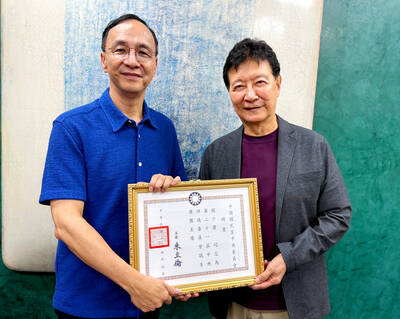
Next week, candidates will officially register to run for chair of the Chinese Nationalist Party (KMT). By the end of Friday, we will know who has registered for the Oct. 18 election. The number of declared candidates has been fluctuating daily. Some candidates registering may be disqualified, so the final list may be in flux for weeks. The list of likely candidates ranges from deep blue to deeper blue to deepest blue, bordering on red (pro-Chinese Communist Party, CCP). Unless current Chairman Eric Chu (朱立倫) can be convinced to run for re-election, the party looks likely to shift towards more hardline
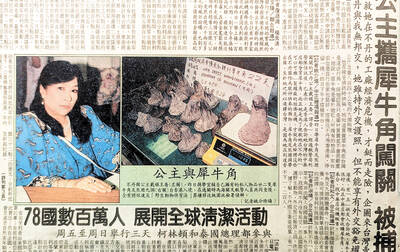
Sept. 15 to Sept. 21 A Bhutanese princess caught at Taoyuan Airport with 22 rhino horns — worth about NT$31 million today — might have been just another curious front-page story. But the Sept. 17, 1993 incident came at a sensitive moment. Taiwan, dubbed “Die-wan” by the British conservationist group Environmental Investigation Agency (EIA), was under international fire for being a major hub for rhino horn. Just 10 days earlier, US secretary of the interior Bruce Babbitt had recommended sanctions against Taiwan for its “failure to end its participation in rhinoceros horn trade.” Even though Taiwan had restricted imports since 1985 and enacted
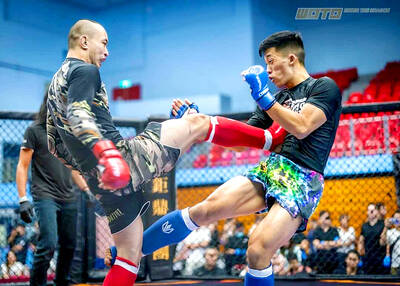
Enter the Dragon 13 will bring Taiwan’s first taste of Dirty Boxing Sunday at Taipei Gymnasium, one highlight of a mixed-rules card blending new formats with traditional MMA. The undercard starts at 10:30am, with the main card beginning at 4pm. Tickets are NT$1,200. Dirty Boxing is a US-born ruleset popularized by fighters Mike Perry and Jon Jones as an alternative to boxing. The format has gained traction overseas, with its inaugural championship streamed free to millions on YouTube, Facebook and Instagram. Taiwan’s version allows punches and elbows with clinch striking, but bans kicks, knees and takedowns. The rules are stricter than the